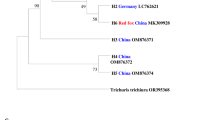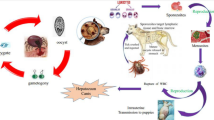Abstract
Trypanosomosis is a common disease in camels and other ruminants, horses, dogs, and of the most important diseases in camels causing huge losses in different countries. Two camel herds in mid-summer of 2014 were involved by wasting infectious disease with cachexia and progressive weakness in southwestern Iran. Upon clinical examination, tachycardia, fever, edema and facial swelling, keratitis, hypopyon, pale mucous membranes, alopecia, dehydration, enlarged lymphatic nodes, and reluctance to move were submitted in a large number of camels. Finally, according to the clinical signs, hematological and biochemical changes, and also observing trypanosomes in peripheral blood smears of camels, trypanosomosis was confirmed. For detection of trypanosome and assuring the virulence of current strain, laboratory-bred mice were inoculated intraperitoneally and subcutaneously with 0.5 ml of buffy coat or whole blood of each smear-positive camel. Parasitemia with anemia was observed in experimentally inoculated mice. Furthermore, the DNA was extracted from the blood and tissue samples of the camels and aborted fetus respectively, and analyzed by nested polymerase chain reaction (nPCR) using specific primers. Disease confirmed and the camels in both herds with the same clinical signs were treated by trypanocide drugs. The signs of trypanosomosis were obviated in all involved camels. It was concluded that trypanosomosis was the cause of abortion and the other observed signs in the camels of Khuzestan province, Iran.




Similar content being viewed by others
References
Abo-Shehada MN, Anshassi H, Mustafa G, Amr Z (1999) Prevalence of Surra among camels and horses in Jordan. Prev Vet Med 38:289–293
Ahmadi-hamedani M, Ghazvinian K, Mehdi Darvishi M (2014) Hematological and serum biochemical aspects associated with a camel (Camelus dromedarius) naturally infected by Trypanosoma evansi with severe parasitemia in Semnan, Iran. Asian Pacific J Trop Biomed 4(9):743–745
Al-Rawashdeh OF, Sharif LA, AL-Qudah KM, AL-Ani FK (2000a) Trypanosoma evansi infection in camels in Jordan. Revue Elev Med Vet Pays Trop 20:233–237
Al-Rawashdeh OF, Al-Ani FK, Sharrif LA, Al-Qudah KM, Al-Hami Y, Frank N (2000b) A survey of camel (Camelus dromedarius) diseases in Jordan. J Zoo Wildl Med 1:335–338
Alton GG, Jones LM and Pietz, DE (1975) Laboratory techniques in brucellosis. In: WHO monograph series No. 55, 2nd edn. WHO, Geneva
Artama WT, Agey MW, Danelson JE (1992) DNA comparison of Trypanosoma evansi (Indonesia) and Trypanosoma brucei spp. Parasitol 104:67–74
Boid R, Mahmoud M, Gray A (1980) Changes in the levels of some serum enzymes in dromedary camels infected with Trypanosoma evansi. Res Vet Sci 28(3):336–340
Chaudhary Z, Iqbal J (2000) Incidence, biochemical and hematological alterations induced by natural trypanosomosis in racing dromedary camels. Acta Trop 77:209–213
Delafosse A, Adoum Doutoum A (2004) Prevalence of Trypanosoma evansi infection and associated risk factors in camels in eastern Chad. Vet Parasitol 119:155–164
Derakhshanfar A, Mozaffari AA, Mohaghegh Zadeh A (2010) An outbreak of trypanosomiasis (Surra) in camels in the southern Fars province: clinical, hematological, and pathological findings. Res J parasitol 5(1):23–26
Desquesnes M, Bossard G, Patrel D, Herder S, Patout O, Lepetitcolin E, Thevenon S et al (2008) The first outbreak of Trypanosoma evansi in camels in metropolitan France. Vet Rec 162:750–752
Dia ML (1997) Epidémiologie de la trypanosomose cameline à T. evansi en Mauritanie. Thèse Doct. Sci. University of Montpellier I, France
El-Baky AAA, Salem SI (2011) Clinicopathological and cytological studies on naturally infected camels and experimentally infected rats with Trypanosoma evansi. World App Sci J 14(1):42–50
Godfrey DG, Killick-Kendrick R (1962) Trypanosoma evansi of camels in Nigeria: a high incidence demonstrated by the inoculation of blood into rats. Ann Trop Med Parasite 56:14–19
Gutierrez C, Juste MC, Corbera JA, Magnus E, Verloo D, Montoya JA (2000) Camel trypanosomosis in the Canary Islands: assessment of seroprevalence and infection rates using the card agglutination test (CATT/T. evansi) and parasite detection tests. Journal of Vet Parasitol 90:155–159
Khosravi A, Hakimi Parizi M, Bamorovat M, Borhani Zarandi M, Mohammadi MA (2013) Prevalence of Trypanosoma evansi in camels using molecular and parasitological methods in the southeast of Iran. J Parasitic Dis 39:422–425
Losos GJ (1980) Diseases caused by Trypanosoma evansi: a review. Vet Res Comm 4:165–181
Luckins AG (1988) Trypanosoma evansi in Asia. Parasitol Today 4:137–142
Luckins AG, Dwinger RH (2004) Non-tsetse-transmitted animal trypanosomiasis. In: Maudlin I, Holmes PH, Miles MA (eds) The trypanosomiases. CABI Publishing, pp 269–282
Nantulya VM, Lindqvist KJ (1989) Antigen detection enzyme immunoassays for the diagnosis of Trypanosoma vivax, T. congolense and T. brucei infections in cattle. Trop Med Parasitol 40:267–272
Ngaira JM, Bett B, Karanja SM, Njagi ENM (2003) Evaluation of antigen and antibody rapid detection tests for Trypanosoma evansi in camels in Kenya. Vet Parasitol 114:131–141
Njiru ZK, Bett B, Mapeny-Ole IM, Githiori JB, Ndung’u JM (2002) Trypanosomosis and helminthosis in camels: comparison of the ranch and traditional camel management systems in Kenya. Camel Pract Res 9:67–71
OIE Terrestrial Manual (2012) Trypanosoma evansi infection (surra). Chapter 2.1.17
Omer OH, Mousa HM, Al-Wabel N (2007) Study on the antioxidant status of rats experimentally infected with Trypanosoma evansi. Vet Parasitol 145:142–145
Pacholek X, Gamatic D, Franek SG, Tibayrene R (2001) Prevalence of Trypanosoma evansi trypanosomosis in young camels in west Niger. Revue Elev Med Vet Pays Trop 44:177–182
Pegram RG, Scott JM (1976) The prevalence and diagnosis of Trypanosoma evansi infection in camels in southern Ethiopia. Trop Anim Hlth Prod 8:20–27
Rafiee A (1979) Comparative veterinary protozology, 1st edn. Research council press of ministry of sciences and technology, Iran
Raoofi A, Kazempoor R, Akbarinejad V, Shojaei M, Tabatabaei SS (2009) Natural trypanosomosis in a Bactrian camel (Camelus bactrianus) in Iran. J Camel Prac and Res 16(2):237–239
Reid SA, Husein A, Copeman DB (2001) Evaluation and improvement of parasitological tests for Trypanosoma evansi infection. Vet Parasitol 102:291–297
Rutter TEG (1967) Trypanosomiasis in camels. Vet Bull 37:611
Saleh MA, Al-Salah MB, Sanousi SA (2009) Oxidative stress in blood of camels (Camelus dromedaries) naturally infected with Trypanosoma evansi. Vet Parasitol 162:192–199
Sazmand A, Rasooli A, Nouri M, Hamidinejat H, Hekmatimoghaddam S (2011) Serobiochemical alterations in subclinically affected dromedary camels with Trypanosoma evansi in Iran. Pak Vet J 31:223–226
Wernery U, Kaaden OR (2002) Infectious diseases in camelids, 2nd edn. Blackwell Wissenschaftsverlag, Berlin
Yagil R (1982) FAO animal production and health paper no. 26. Camels and camel milk. Food and Agriculture Organization of the United Nations, Rome, p. 41
Zia-ur-Rehman (1992) Serum biochemical, enzymes and hematological changes in one-humped camels infected with Surra. Proceedings of the First International Camel Conference, Dubai , p. 405February 2-6
Author information
Authors and Affiliations
Corresponding author
Ethics declarations
Ethical approval
All procedures performed were in accordance with the ethical standards of the ethical research committee of Shahid Chamran University of Ahvaz and were in full compliance of the principles of animal welfare.
Conflict of interest
The authors declare that they have no conflict of interest.
Rights and permissions
About this article
Cite this article
Zakian, A., Nouri, M., Safaei, P. et al. An acute outbreak of natural Trypanosoma evansi infection in camel (Camelus dromedarius) herds in the southwestern Iran. Comp Clin Pathol 26, 51–59 (2017). https://doi.org/10.1007/s00580-016-2345-7
Received:
Accepted:
Published:
Issue Date:
DOI: https://doi.org/10.1007/s00580-016-2345-7




